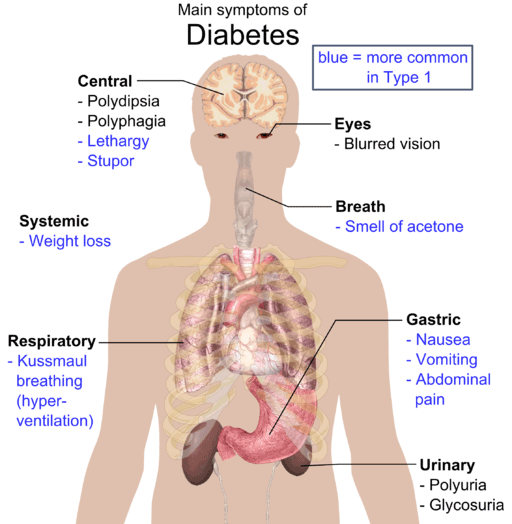


Diabetes mellitus commonly referred to as diabetes, is a group of metabolic disorders in which there are high blood sugar levels over a prolonged period. Symptoms of high blood sugar include frequent urination, increased thirst, and increased hunger. If left untreated, diabetes can cause many complications. Acute complications can include diabetic ketoacidosis, hyperosmolar hyperglycemic state, or death. Serious long-term complications include cardiovascular disease, stroke, chronic kidney disease, foot ulcers, and damage to the eyes.
Diabetes is due to either the pancreas not producing enough insulin or the cells of the body not responding properly to the insulin produced. There are three main types of diabetes mellitus:
• Type 1 DM results from the pancreas's failure to produce enough insulin. This form was previously referred to as "insulin-dependent diabetes mellitus" (IDDM) or "juvenile diabetes". The cause is unknown.
• Type 2 DM begins with insulin resistance, a condition in which cells fail to respond to insulin properly. As the disease progresses a lack of insulin may also develop. This form was previously referred to as "non insulin-dependent diabetes mellitus" (NIDDM) or "adult-onset diabetes". The most common cause is excessive body weight and not enough exercise.
• Gestational diabetes is the third main form and occurs when pregnant women without a previous history of diabetes develop high blood sugar levels.
Insulin Dependent TYPE 1
Type 1″ diabetes (previously called insulin dependent diabetes mellitus) results from absolute deficiency in insulin production. It commonly occurs before age 30, but may occur at any time during life. Type 1 diabetes is controlled with insulin. In the UK, of 100 people with diabetes, approximately 8 will have Type 1 diabetes.
Type 1 diabetes is usually diagnosed in children and young adults, and was previously known as juvenile diabetes. Only 5% of people with diabetes have this form of the disease.
Insulin is a hormone that is needed to convert sugar, fats and proteins into energy needed for daily activities in our life. In type 1 diabetes, the body does not produce insulin. With the help of insulin therapy, proper education and other modalities, all people with type 1 diabetes can learn to manage their condition and live long, healthy lives.
Non Insulin Dependent Complex TYPE 2
Type 2 diabetes is the most common form of diabetes. It usually affects older people and develops when the pancreas is unable to produce sufficient insulin to overcome the body’s resistance to its affects. In type 2 diabetes, either the body does not produce enough insulin or the cells ignore the insulin. This type of diabetes may be controlled with a healthy diet, regular exercise and oral medication. In some cases insulin treatment may also be required.
Type 2 diabetes is more common in African Americans, Latinos, Native Americans, and South Asians that includes Indians.
Monogenic diabetes including neonatal diabetes and maturity onset diabetes of the young (MODY).
MODY is typically diagnosed in adolescence or early adulthood and can look like type 1 or type 2 diabetes. Some people with MODY might be thin; others might be overweight. Some could be in DKA at diagnosis, while others might just have lifelong, slightly elevated blood glucose levels, with no developing need for insulin treatment. arious genes contribute to type 1 and type 2 diabetes, but some forms of diabetes depend on a single gene. There are 12 known types of diabetes caused by the mutation of different single genes, all under the umbrella of MODY(Maturity Onset Diabetes of the Young).
Insulin-Resistant Type 1
This condition is diagnosed in people with type 1 diabetes and those who have features of insulin resistance including abdominal obesity, low HDL cholesterol, high triglycerides, and a family history of type 2 diabetes. This group of people with type 1 diabetes are more prone to develop complications like type 2 diabetes including heart attack, stroke, kidney problem etc. Lifestyle modifications including controlling diet and increasing exercise may benefit but this is not straight forward in people with type 1 diabetes.
LADA
Latent Autoimmune Diabetes in Adults (LADA), is slowly developing autoimmune type 1 diabetes that presents in adults. People with LADA may not require insulin for months or years. IN this type of diabetes there is a gradual destruction of the beta cells of the pancreas which produces insulin.
People with LADA are often diagnosed at first with Type 2 diabetes. Some people refer to LADA as Type 1.5.People with LADA behaving differently and their treatment is also variable. Some may need insulin immediately others may remain controlled with tablets for long duration.
People with suspected LADA need to be investigated to establish if they have insulin antibodies or islet cell antibodies.
Gestational Diabetes Mellitus
Gestational diabetes is a type of diabetes that affects pregnant women, usually during the second or third trimester. Women with gestational diabetes don’t have diabetes before their pregnancy, and after giving birth it usually goes away. Gestational diabetes is usually diagnosed through a blood test at 24–28 weeks into pregnancy. You are at an increased risk if you:
• are overweight or obese
• have had gestational diabetes before
• have had a very large baby in a previous pregnancy (4.5kg/10lb or over)
• have a family history of diabetes (parent, brother or sister)
• are from a South Asian, Black or African Caribbean or Middle Eastern background.